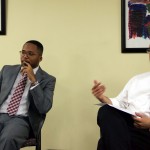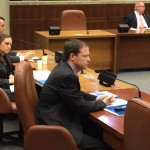Massachusetts Gov. Charlie Baker announced in a Thursday press release the creation of a government task force of state government officials and appointed community members to address chronically unemployed populations in Massachusetts.

The task force will investigate the causes of chronic unemployment of the “targeted populations,” including African Americans, Hispanic and Latino Americans, veterans and persons with disabilities, the release stated.
The task force will have until Nov. 15 to identify the barriers to employment experienced by the targeted populations and provide recommendations for improvement, the release stated.
“Too many Massachusetts workers have become discouraged as a growing economy unfortunately leaves them behind,” Baker said in the release. “This task force will build upon the workforce development practices we know work and replicate them across the Commonwealth to create more opportunities for employment everywhere.”
The Massachusetts Executive Office of Labor and Workforce Development’s website reports the state’s unemployment rate at 5.1 percent, its lowest point since the recession of 2008. Kevin Lang, a professor of economics in Boston University’s College of Arts and Sciences, said this is a positive development.
“Nothing can take away from this being generally being good news,” he said. “We would like the employment rate to be as low as possible without getting to the point where inflation starts taking off. General estimates would say that we’re getting close to that, [and] some people would say that we’re already there.”
However, Lang said the measures used by the U.S. Department of Labor’s Bureau of Labor Statistics to gather unemployment data on a state-by-state basis are limited in scope.
“People should be aware of the limits of the unemployment measure,” Lang said. “It measures whether people are working at all versus people who are searching for work. People who are not searching for work are not [considered] unemployed regardless of whether they’d like to be.”
This means that though the 5.1 percent figure is considered “full employment” to some, it fails to account for individuals who have given up searching for gainful employment after years of trying.
Massachusetts’ Labor Participation Rate, which reflects the number of working-aged residents who are employed versus those who do not have jobs, can be considered a more accurate measure of the health of the labor market because it includes all unemployed persons, regardless of whether they meet the government standard of having searched for a job within the last 4 weeks, Lang said.
Massachusetts’ current Labor Participation Rate is 65.6 percent, a statistic Ann Dufresne, the communications director for the Massachusetts Executive Office of Labor and Workforce Development said is “abysmally low.”
Dufresne said raising this percentage is another goal of the task force.
“Another function of the cabinet and the task force is to look at how do we increase labor force participation rates … What’s holding these people back from getting on a career path?” she said.
The unemployment rate does not accurately reflect the condition of the Massachusetts labor market, said Chris Horton, volunteer organizer for the Worcester Unemployment Action Group, whose mission statement calls for the allocation of federal funds away from corporate bailouts and toward local infrastructure projects that can stimulate the creation of living-wage jobs.
“This falling unemployment rate does not reflect people going back to work. It reflects people giving up,” said Horton, who was laid off from his job as a school teacher, which he said was a “devastating” experience.
“We have an unemployment assistance system that has become highly dysfunctional. There is no longer an unemployment office that you can go to to meet someone face-to-face who has any power to do anything at all,” he said. “So now it’s all by phone or online, and many people have difficulty navigating that.”
The shift from an in-person application process to a digital one creates a barrier for citizens without a reliable internet connection to seek unemployment benefits or career counseling services, Horton said, and the automated phone system is purportedly known for its long wait times and its tendency to boot callers from the line mid-call.
As the Massachusetts economy continues to grow, the Office of Labor and Workforce Development is looking to address the employment needs of those left behind, who are often low-wage workers whose industry jobs were lost to the great recession, Dufresne said.
“We know there’s a group of 182,000 people who don’t work,” she said. “The governor wants to find out why this group has a persistent unemployment rate.”
Several residents said education plays an integral part of employment, and the government should focus its efforts on fixing the education system rather than the employment system.
Brian Kimbal, 22, of Allston, said the government plays a role in ensuring its citizens are properly educated for the changing labor market.
“The education of the populous is one of the government’s most important roles, and that is very much an inherent part of the job market,” he said. “It’s the government’s role to give people proper education which can then get them jobs.”
Phil Wilcox, 27, of Jamaica Plain, said Baker’s recently conceived task force falls short of comprehensively addressing the disparate rate of unemployment in so-called “target populations.”
“A task force is not enough to get to the root of the problem, and it kind of seems like lip service a little bit,” he said.
Heather Blais, 29, of Allston, said education reform would be a more effective measure toward alleviating unemployment within target populations.
“If more money was given to educational outreach programs within the school system, they [the government] would prevent the problem from happening,” she said. “The government should be starting younger, starting with these groups when they’re younger and showing them what’s available before it’s too late.”
CORRECTION: A previous version of the story stated that all brick-and-mortar locations for career centers had been eradicated, but Chris Horton said he does not find them helpful in the application process, not that they do not exist. The story has been updated to reflect this change.




